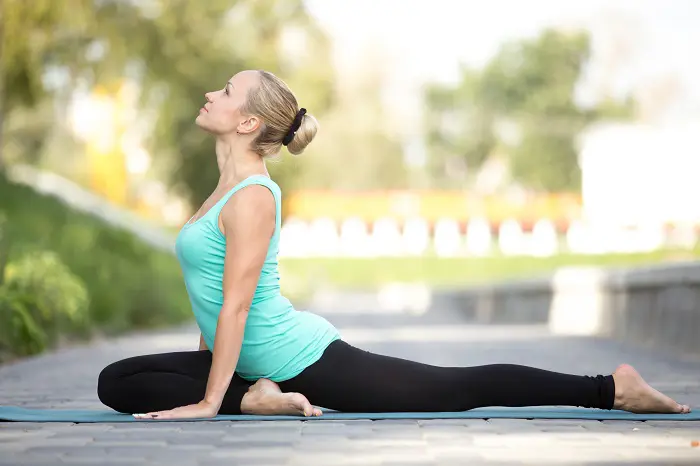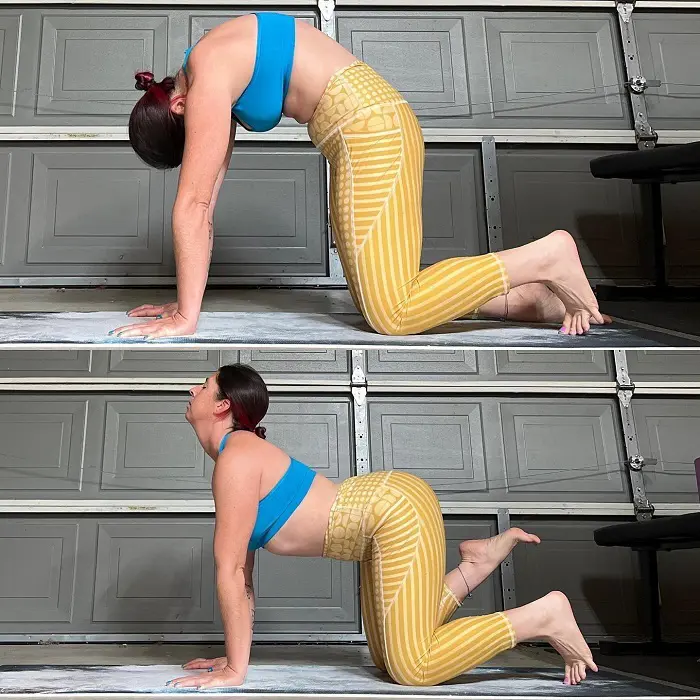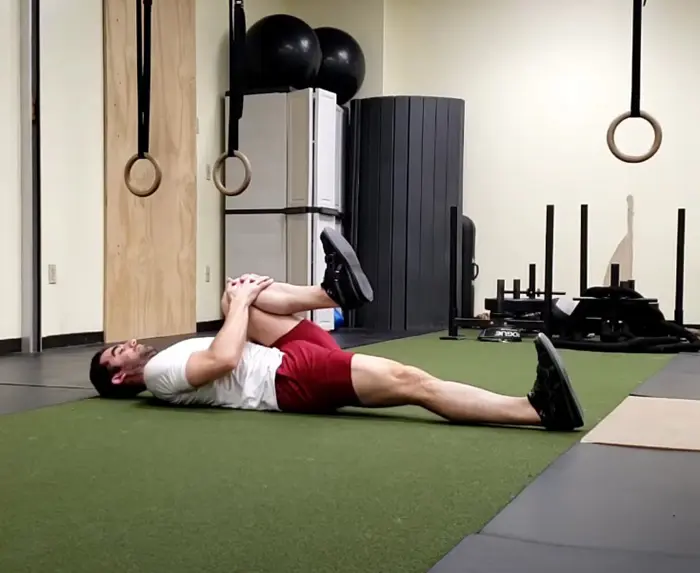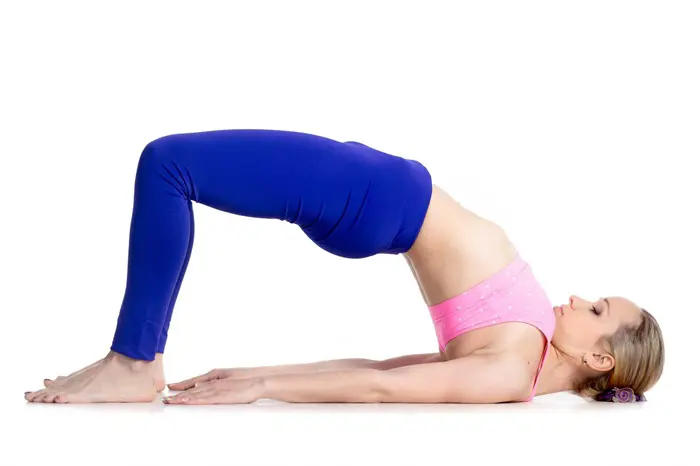Tailbone Pain Exercises For Coccyx Pain Relief

Are you struggling with tailbone back pain that makes daily tasks uncomfortable? The key to relief lies in understanding the cause of the discomfort and adding a specific exercise to your routine.
Regularly practicing these workouts can help you minimize coccyx pain and maximize comfort. Here are some easy-to-do yet powerful tailbone pain exercises to help you regain your well-being and eliminate tailbone discomfort naturally:
1. Pigeon Stretch

Pigeon stretch is an excellent exercise to ease your tailbone discomfort. It focuses on the hip and lower back muscles, releasing tension that may be causing the coccyx issues.
At the same time, this stretch relaxes the hip flexors. Doing this exercise regularly increases agility in the tailbone region.
Steps To Do:
- Begin in a tabletop position.
- Bring your right knee between your hands.
- Place your hips down and rest them on your right leg while stretching the left leg back.
- Keep your hips square and balance your body.
- Remain in this position for 30 seconds.
2. Bow Pose

This is another fantastic stretch to mitigate the pain of the coccyx. It allows full body stretch while supporting the hips and the back. Bow Pose stretches your spine and core to release the tension.
Steps To Do:
- Lie flat on the ground, facing the surface.
- Curve your legs upward and grab your ankles with your hands.
- Pull your legs as you raise your torso off the ground.
- Hold this position for a few seconds.
3. Child’s Pose

Child's pose elongates your spine while impacting your tailbone, thighs, and ankles. In this position, you sit on your folded legs with your hands extended forward.
Steps To Do:
- Kneel and sit on your legs.
- Take your body forward and hands in front of you.
- Tilt your head down to the ground and breathe deeply.
- Remain in this position for 3 minutes.
4. Cobra Pose

Cobra pose is a simple workout that can be easily performed at your home. It strengthens the lower back. Practicing this pose regularly diminishes the pain and improves tailbone flexibility.
Steps To Do:
- Lie flat on your belly.
- Press your hands against the floor to lift your torso, bringing your chest forward.
- Take a deep breath, while you stretch your lower back and spine.
- Hold the position for 30 seconds.
5. Side Angle Stretch

In this pose, you extend your body sideways from your foot to your fingertips. It helps alleviate discomfort in the coccyx as well as gradually ease tailbone pain over time.
Steps To Do:
- Begin in a standing position with your feet stretched wide apart.
- Bent your front leg while keeping the back leg straight.
- Lower your arm toward the front bent leg.
- Lift your other arm upward.
- Be in this position for a few seconds and repeat on the other side.
6. Cat-Cow Pose

Another ideal exercise for relieving tailbone pain is the cat-cow pose. It stretches both your lower and upper back. By moving your torso up and down, you can soothe and release tension.
Steps To Do:
- Start in a tabletop position.
- As you inhale, lift your head and tailbone upward while arching your torso downward.
- While you exhale, round your torso upward and lower your head and tailbone.
- Do it for several breaths, alternating the two positions.
7. Single Knee Chest

Single Knee chest exercise provides comfort on your tailbone area and stretches thigh muscles. Further, this exercise also aids in controlled motions.
Steps To Do:
- Lie flat on your back and ease your legs.
- Bring a leg up toward your chest, bending your knee.
- Put your hand on the knee to gently pull toward your chest and feel the slight stretch.
- Hold for a few seconds and repeat it on the other leg.
8. Piriformis Stretch

This posture helps to lower your pain, muscle aches, and pressure on the tailbone. It effectively engages the gluteal muscles around the coccyx.
Steps To Do:
- Lie on your back, with your legs flat and relaxed.
- Cross one leg over the other to make a figure-four.
- Hold your lower leg and pull it towards your chest.
- Remain in the position, feeling your muscles stretching, for 30 seconds.
- Switch legs and repeat on the other side.
9. Triangle Pose

The triangle pose can ease discomfort and strengthen the coccyx. It also improves flexibility and balance. This exercise aligns the bone in its proper position. This pose is similar to a side-angle stretch but does not involve a bent knee.
Steps To Do:
- Spread your legs wide with your knees straight.
- Try to reach the ground with one arm, keeping it straight.
- Raise another arm in the air while bending at your waist.
- Maintain this pose for a while and repeat on the other side.
10. Pelvic Lifts

This stretch helps to adjust the pelvis and alleviate irritations in the region around the tailbone. Pelvic lifts also strengthen the lower back, hips, and glute muscles. Furthermore, it stretches and relaxes the tense muscle that supports the coccyx leading to a better feeling.
Steps To Do:
- Lie on your back.
- Place your feet firmly on the ground bending your knees.
- Slowly raise your pelvis upward.
- Feel the muscle tightening and hold the position for a few moments.
- Repeat for 10 reps.
Tailbone Exercise Benefits

Distress in the tailbone can hinder our daily physical activities. Performing the exercises mentioned above can support the tail vertebrae by building healthy muscle around it and strengthening it.
Tailbone exercises improve flexibility, reduce pain, and provide body balance. Let's look into six different benefits.
1. Reduces Pain
These exercises lower the pain by relieving tension and discomfort in the tailbone. Performing these exercises daily will strengthen and stretch the muscles around the coccyx region.
Specific postures, such as the pigeon stretch and bow pose, decrease pressure on the tailbone and help release muscle tension.
2. Improves Flexibility
Regular practice of these exercises enhances muscle elasticity and range of motion. For example, the child pose and triangle pose stretch the muscles making them more elastic and supple.
Increased flexibility, further, aids in spine alignment, reduces stiffness, and minimizes stress.
3. Strengthens Muscles
Tailbone exercises target the lower back area, strengthening the surrounding muscles. These exercises benefit the muscles around the coccyx, providing support and stability as well.
While performing these exercises, stress on the tailbone diminishes significantly. Less stress and better stability provide comfort in daily activities.
4. Enhances Blood Circulation
The muscles and tissues around the coccyx receive increased blood flow after engaging in these workouts. This enhanced circulation delivers vital nutrients and energy to that specific area of the body.
As the blood movement improves, metabolic waste products are cleared, contributing to the cessation of pain.
5. Supports Pelvic Health
These activities focus on the pelvic area and the adjacent muscles, promoting and maintaining pelvic health.
By engaging and strengthening these muscles, the exercises enhance functionality and stability, ultimately aiding in proper body posture.
6. Promotes Recovery
The aforementioned workouts increase the speed of recovery for injured tissues and muscles. They reduce the stiffness and retrieve mobility in the tailbone area, engaging the body to heal itself.
With improved blood flow, healing occurs in a shorter time frame than expected. Regular practice of these workouts helps prevent injuries by restoring proper function.
Safety Tips And Precautions
Safety measures should be followed while doing this exercise to prevent pain and suffering in the tailbone. Warming up before exercise and maintaining the right postures can avoid injuries.
To minimize the risk of harm and possible injuries, consider the following safety tips while exercising:
- Do some light exercises to make your muscles and joints ready for the movement, reducing the risk of strain.
- Have any necessary props, such as cushions or mats, ready to support your tailbone exercises.
- Be mindful of any pain or discomfort. If you experience sharp pain, stop immediately.
- Ensure you are performing the exercises correctly. Proper form enhances body posture and reduces the risk of pain.
- Begin with simple exercises, then gradually increase the intensity. This gives your muscles time to adapt and improves flexibility.
- Make sure to breathe steadily throughout the exercises. This helps relax you and provides sufficient oxygen to your body.
- Avoid pushing yourself too hard to prevent injury.
How Long To Do Tailbone Exercises?
A trainee can perform tailbone exercises based on their individual needs and rigidity. Normally, these exercises are to be performed at least 15 minutes regularly. To be more familiar with the exercises and perfectly accomplish them, create a daily routine.
As you become more comfortable and flexible, gradually increase the duration of your workouts. However, avoid pushing yourself to the point of causing serious injury. If pain persists after some time, seek medical advice.
When To Visit A Doctor?
It is crucial to note your symptoms and be ready to consult a doctor if you have pain in your coccyx. Most of the time, the tailbone pain can be treated with workouts and home remedies. But in case your pain is not stopping, then you should consult with the doctor. There may be underlying issues that need to be addressed.
Do not ignore the pain that hinders your day-to-day activities, even when it causes suffering as you sit, stand, or walk. The doctor can perform the required analysis and clinical examination to find out the root cause of your suffering and counsel correspondingly.
Recent posts
Exercises
Exercises
15 Pull Day Exercises To Add To Your Workout Routine
In the fitness world, a pull day is a workout day that targets the muscles involved in pulling motions - think biceps, lats, traps, rear delts, and forearms. Regularly working these muscles helps build strength and improve muscle tone. Pairing a pull...
Exercises
12 Easy SI Joint Stretches And Exercises To Reduce Pain
Pain in the SI joint can be frustrating, as it makes basic day-to-day movements uncomfortable. However, specific stretches and exercises can help reduce this discomfort by increasing mobility and flexibility around the sacroiliac joint. These exercis...
Exercises
12 Gluteus Medius Exercises For Stronger And Flexible Hips
The gluteus medius muscle, present in the outer hips, plays a key role in everyday activities like walking, running, and squatting. If this muscle is strong, these activities will feel much easier. Strengthening this muscle is also essential for stab...
Exercises
15 Cable Arm Exercises To Grow Biceps And Triceps
Working out your arms in the gym is a great way to build strong, toned muscles. Cable machines are especially useful for this, as they can help you quickly develop jacked arms. In this article, we shall explore 15 cable arm exercises for your biceps ...
Exercises
12 Vagus Nerve Exercises To Combat Stress And Anxiety
Activating the vagus nerve is a powerful way to reduce stress and anxiety. By performing specific exercises that stimulate this nerve, we can encourage our bodies to heal and enhance overall functionality. These activities, which aim to create a sens...
Exercises
12 Lower Chest Exercises To Get Chiseled Pecs
Everyone wants a strong, defined lower chest to complete their upper body look and boost their confidence. Several exercises target this area, helping us achieve the desired aesthetic. From the decline bench press to the seated machine fly, there are...






